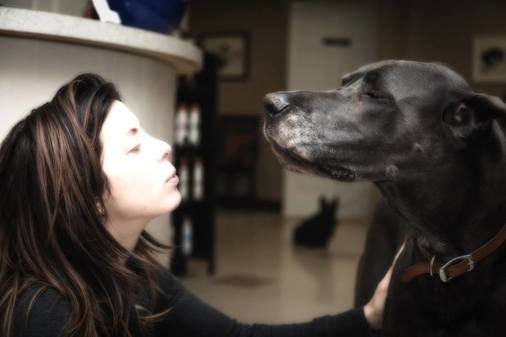|
During this time of year, veterinary advice columns put out warnings for your pets that include antifreeze poisoning, ingestion of ornaments/toys/etc., salt ingestion from de-icing products, chewing on seasonal lights and electrical cords, poisonous seasonal plants, and dietary disturbances from eating fatty foods and sweets sitting on table tops. These are all issues that veterinary hospitals deal with during the season, and as pet owners, you should be aware of them…and, although pet safety is important, I would like to dedicate this time to an area that is often overlooked.
We all know the holiday season can bring on a multitude of stressors for us. The combination of colder weather, decreased sunlight, the end of a year, unmet expectations, deadlines, pressures of the season, financial stressors…as joyous as this time of year is supposed to be, it comes with stress – stress that our highly intuitive pets share. For the majority of us, our pets primarily live in our homes and are part of our families. Our pets are no longer using their senses to avoid predators and hunt for food, instead they are more sensitive to their families and their immediate surroundings, both of which undergo changes during the holidays. For about 6 weeks their ‘world’ goes through some big shifts and we often overlook how our pets may be affected. I ask that you think about the following examples of what may be going on in your home, and be sensitive to how your beloved companions are adjusting to it…especially our older pets: • Weather, weather, weather • Furniture moved/removed to make way for Christmas trees and decorations • Yard decorations • Lights…and more lights • Scented candles, cinnamon, pine, and other fragrances • A live tree…in the living room! • Packages, UPS/FedEx, door bells • Christmas music, singing, and fireworks at New Years • Phone calls and visitors • Baking, cooking, candy…food and more food • Holiday parties and guests • Owner/family arguments, tension, stress, exhaustion, depression I hope you can see that every part of their little microcosm is disrupted. For clarity, I am not saying your pets won’t enjoy some of these changes…or act excited about the season, I am merely explaining that their life is undergoing a stressor…good or bad. The reason to be sensitive to these items is that they can be a catalyst to physical, emotional, and behavioral changes in your pet. Please take a moment to slow down and observe your furry companion for changes in their eating, drinking, urination/defecation, and attitude. They can be over stimulated by these items and start hiding, avoiding areas where the Christmas décor is located, shaking and whining more, chewing or licking on themselves, sneezing or experiencing eye irritations...and even seizures. For example, If you get a lot of packages at this time a year, the delivery trucks and doorbells can magnify anxiety to a new level! You may consider putting a note on the door for UPS/FedEx/USPS to not ring the doorbell, or to leave packages in locations that would be less stimulating to your pets. Also, try not to leave stuff all over the floor that may make your pets travel through the house obstructed. I suggest considering placing your pet on a natural anti-anxiety supplement during the season (inexpensive and non-pharmaceutical based). If your pet is already struggling or you anticipate problems, as the holidays near, please have a discussion with your veterinarian – we have better success treating these issues proactively vs. waiting for a significant episode. In closing, even if you can’t change any of the obvious stressors…the most important thing that you can do is to make sure you take care of your own physical and emotional health. Our pets take cues from us and they need to sense you are okay so that they can be okay. Please take the time to de-stress a little before you come in that front door and make the conscious decision to find something positive to focus on…it is important that you and your pet not only survive this holiday time, but also enjoy it! Happy Holidays!! -Dr. Vamvakias
5 Comments
One of the most common requests I get from owners, is to maintain an honest and open conversation about the quality of life their pet is experiencing. They want as much time with their pet, but they don’t want to be selfish and prolong a diminished quality of life for their beloved dog or cat. The idea of “quality of life” is a very subjective topic and is argued across the scope of human and veterinary life. We all have a different idea of what quality looks like. Recently, I had a wonderful client come to me with this same concern. Despite her absolute and unrelenting love for her dog and her dedication to his weekly treatments for osteoarthritis and back pain, she was burdened with the idea that she was possibly asking him to live in pain. What is important to remember in medicine, both veterinary and human, many times we cannot completely eliminate all of the pain…the main goal is to manage the pain so patients can still enjoy life.
We had a good discussion about this subject, so I decided to share a part of our discussion in hopes it may help another. For clarification, the opinion and beliefs I am expressing only reflect my personal beliefs as a veterinarian for the last 23+ years…no one else’s. Pain, both emotional and physical, is an absolute in life…you cannot escape it. We all work to find ways to manage it and deal with how it will influence our quality of life in that moment, hour, day, etc. With our pets, especially our older ones, they are most likely in some form of pain…I am not trying to convince you, I am stating it. I hear “they don’t show pain” but they do, you just don’t know how to identify it…but that is another discussion. My point is they have good and bad days just like us. Yes, it isn’t as complex as our days, but they have a lot to process. Our pets have emotions and how they are feeling and the environment they are living in will flux just like yours. They pick up on the weather, the storms, the noises, your moods and the moods of those in your house, your routines and their routines, food changes, smells…it all affects them…then add in the pain of osteoarthritis or chronic stomach/intestine issues or skin allergies or dental disease or ear infections…they have their own little life going on. So how do you look at the quality of their life and making decisions on their behalf, especially when it comes to big life decisions? As a mother of three boys, when they were younger they would come home with little reports depicting their behavior in class. I can’t remember which child, or which teacher, or even which school it was…but I used to have to sign a calendar at the end of each month. On the days of the week there were the options of a smiley face, a neutral face, and a frowning face. The faces were to communicate the overall behavior of my child on that day. Other teachers used colors such as red, yellow and green…but I remember the calendar the most. Many times there was a small note if a teacher felt an explanation was needed, but it was a very quantitative look at how my child was behaving in class. I tried not to point out any individual day to my child…because they rarely would remember anything about that day…but it did give me a ‘big picture’ summary of things. The reason I am describing this in such detail, is that I told my client that we should resist the temptation of making decisions on quality of life for our pets based on any one particular bad day. My recommendation is to keep a calendar of faces, and on days that are good… if her furry soul mate was eating and drinking, wagging and walking, and joyful in her presence then he gets a smiley face. If he has a neutral day where it was neither great nor bad, then record a neutral face…and obviously if he seemed more uncomfortable, reluctant to move and not taking treats, record a frowning face. Get a bigger picture of how things are, and remember your impression of his days will be greatly influenced by the pain and struggles of your own day. If there are more bad days than good, it becomes a more convincing illustration of his quality of life. My last recommendation was on the days that are not great, just be his friend. Try not to project your emotions of dread or sadness or doubt on him, rather assure him of your love and support and the promise of a better day tomorrow. The interesting thing about what I have written is that it doesn’t just apply to a child’s behavior or the quality of life your pet is experiencing. If inclined, you can use this very simplistic approach to evaluating a job, friendship, relationship, marriage, etc. I cannot set the parameters for you on what constitutes each face, you will need to do that, but obviously if you see more frowning faces than smiling…you are not living your best quality of life and you may need to make some changes. -Dr. Vamvakias Chronic pain is a topic that is near and dear to my heart. I have a 12 year old boxer with severe osteoarthritis in his knees secondary to cruciate ligament ruptures and an OCD (osteochondrosis dissecans) lesion. He has had three knee surgeries, and his first was at the age of two. As a result of this, over time, he has developed degenerative joint disease.
In addition to pain in his knees, my boxer also has secondary back and shoulder pain. This has most likely developed from years of offloading greater than the normal weight bearing load (60%) onto his front legs and holding tension along his back and neck. This type of compensatory pain is commonly seen in our veterinary patients, especially in cases where chronic compensation has had to occur. These findings are similar to those in people; it is common for a person with chronic knee pain to develop lower back pain over time. Osteoarthritis is just one example of chronic pain. Chronic pain can come in the form of cancer pain, muscle pain, pancreatitis, high blood pressure (mainly a concern for cats), ocular (eye) pain, etc. For the purposes of this blog post, I am going to focus on musculoskeletal chronic pain. In a case like my boxer's, there are a few initial questions to answer. 1. How do I know if my pet has pain? It is very common for our stoic pets to "hide" this pain from us. They may still eat and drink normally. They often still get excited to go on walks. And they typically still express their excitement to see us. My boxer will run, jump and spin in the air, even without any pain medications. He will play with the other dogs and jump in the lake without hesitation. After these activities, after he has been sleeping and on bad days, he will be so stiff that he is toe touching in his back legs and offloading 80% to 90% of his weight on his front legs. He never cries out, or vocalizes, at all. He eats normally (picky eater that he is). Besides his stiffness, he does not EVER tell us he is painful. So, what should an owner look for? Any lameness. If your pet is not weight bearing, or off loading weight onto other limbs, there is pain. Reluctance to go up or down stairs, hesitation or resistance to jumping, and moving slower when getting up are all also possible signs of pain. Generalized changes in behavior may be an indication that something is going on. A "stiff" appearing neck is a big one. Neck pain is fairly common and it can present very acutely... and it HURTS! Neck pain can also present with forelimb lameness, since the nerves that innervate the forelimbs originate from the cervical (neck) spine. 2. How long has the pain been present? Is there an acute injury, or has there been a lameness present for several weeks or months? If the lameness has been present for more than two weeks, it is considered chronic. Have the signs of pain changed over the past weeks, or months? Has it improved? Worsened? Shifted? Have other behavioral changes developed that might be associated with the presence of the pain? These are all important questions to consider and will help your veterinarian during their assessment and treatment plan formulation. 3. Is this just a normal age related change? This a very common question that I encounter. How do we determine between pain and what we might consider slowing down related to age? It is not an easy question to answer. I think that this really starts with an assessment. From that assessment a treatment plan will be formulated. This plan will be tailored to your lifestyle and your pet. But the most important advice I can give you is that often times we do not know the level of pain our pets are in until we implement a pain management treatment plan. Often times once we find the right therapy program, we see that our pets were not actually showing age, but that their activity limitations were associated with just how uncomfortable they truly were! This was absolutely true for my boxer! I knew he was painful, that was not a question. And, he was getting older - 12, no spring chicken! And I thought I was addressing his pain to the best of my ability (besides the bilateral total knee replacements recommended by an orthopedist). I had him on glucosamine supplementation, adequan, an NSAID, gabapentin and omega fatty acid supplementation. He received therapy laser, acupuncture and chiropractic sessions. He was a hydrotherapy failure, so that was off the table. We put him in the hydrotherapy pool once, with a life vest on (this is a dog that LOVES to swim in the lake), and he completely froze and literally rolled onto his back. In the underwater treadmill, he refused to walk! No treat was good enough as he is not highly food motivated. He would just sit on the treadmill as it pushed him to the door. Absolute refusal. He really was not cooperative for his other therapy either, but at least we could get a few reps in. Overall, I thought that his pain management program was pretty solid. And he did show significant mobility improvement. I was happy with his progress and maintenance. Then we decided to perform steroid joint injections in his knees. It was life changing! I mean my dog was running, jumping, playing, hunting and going on LONG walks! He was acting like his five year old self. It was AMAZING! What I learned from this experience was that, we often do not know the level of pain our pets are in until we treat it with the right combination of therapy for them. I suspect that a lot of our pets with chronic pain actually slow down due to just that - the lingering pain, and much less from age related changes. Joint injections were the ticket for my boxer. 4. What can I do to alleviate and better manage my pet's pain? Great question! The first step is getting your pet in for a veterinary consult. When going in for the consult, start thinking about the questions we discussed above. Another very important consideration is what your limitations as an owner are going to be. When developing a pain management plan, it will only be successful if there is commitment on the part of the pet owner. This means that it is important to determine if there are logistical, financial or other limitations. And it is OK to have limitations! We all have them. It is important to consider them so that we can develop a plan that has the highest probability of success. It is also important to consider your expectations for your pet. In a perfect world, we could eliminate any source of pain 100%. This is not always going to be the case. There will be some cases, like my boxer, that will always have some level of pain. In these cases, our goal is to minimize this pain and to slow or prevent progression of the disease process contributing to it. Osteoarthritis is a great example of this. We cannot get rid of osteoarthritis (unless it is one of those rare cases where a joint replacement is an option - both surgically and financially). Therefore, our goal must be set to manage and minimize this pain. When developing a plan for chronic pain management, we typically take a multimodal approach. This can be a bit overwhelming to take in at first. Just remember, like with my boxer, approaching the pain from more than one aspect will give us the best chance of alleviating it, or at least minimizing it. A multimodal pain management plan is one that combines many therapies to decrease pain. At Vanguard Veterinary Hospital, we utilize a combination of pharmaceutical therapy (non-steroidal anti-inflammatories and pain medications), nutraceutical therapy (supplements), manual therapy (physiotherapy and hydrotherapy) and alternative therapy (chiropractic adjustments, acupuncture and therapy laser). In some severe cases of chronic pain, we will recommend hospitalization and we will administer intravenous systemic pain medications to help "dampen" down the pain sensation. As discussed with my boxer, there are cases where we perform loco-regional pain management. The loco-regional management may be in the form of a local anesthetic injection called Traumeel, or joint injections. The joint injections may be steroid injections, stem cell injections, PRP or IRAP injections. Like I said - so many options! Imagine the combination of options available. Each pet is different, and the recommendations for pain management is going to vary on a case by case basis. And, since our pets do not experience the same sensations from one day to the next, our treatment for them must be able to change as their needs change. And that is a great thing. It allows us to have so many different options for treatment. It allows us to alter treatment as needed. And for me, and my boxer, it has made a world of difference. If you have a pet that you think might be experiencing chronic pain (cats not excluded!), schedule an assessment to see if there is a source of pain, and to learn what we can offer you! |
Archives
December 2017
Categories |
HELPFUL INFO
OFFICE HOURS
Monday 8:00 am to 5:00 pm Tuesday 8:00 am to 5:00 pm Wednesday 8:00 am to 5:00 pm Thursday 8:00 am to 5:00 pm Friday 8:00 am to 5:00 pm Saturday Closed Sunday Closed |
Get In Touch
VANGUARD VETERINARY HOSPITAL
1995 Juniper Lake Rd. West End, NC 27376 Phone (910) 420-2902 Fax (910) 420-2847 Tell the world what you think of us. Review us online.
|
Our Partners In Care
|
Site powered by Weebly. Managed by IDEXX Laboratories

 RSS Feed
RSS Feed












